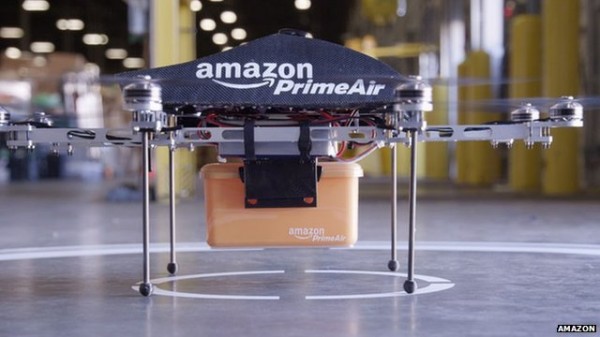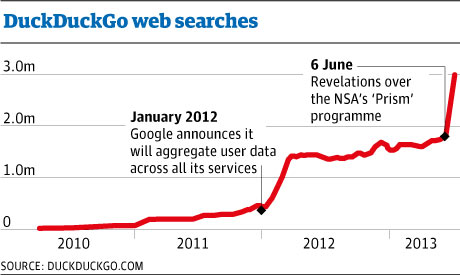So 60 Minutes gave Amazon’s Jeff Bezos a platform to tout his company’s next great idea – Prime Air, a 30-minute delivery service via small unmanned aerial vehicles.
The service, which is still in the testing phase, will be made possible, if it ever gets past the testing phase, by small drones called octocopters, which are drones with eight helicopter-like rotors.
As envisioned by Amazon, these drones will deliver packages weighing up to 5 lb (about 2.3 kg) to customers within 30 minutes of placing an order.
Sounds like a great idea, but one that’s froth with technical and logistical problems. I’ve read many potential issues that could kill this idea in other blogs, but the best argument why Prime Air is dead on arrival comes from David Axe. Here’s part of what he wrote:
Based on my rough calculations, a FedEx driver and his truck cost $40,000 a year to acquire and operate — including the truck’s purchase price spread over a decade of use. A typical driver can deliver 75 packages a day. It would take at least six drones costing $300,000 to do the same amount of work, assuming the robots always work perfectly. The drones would have to fly 12 hour-long, round-trip deliveries five days a week for eight years in order to be even a dollar cheaper than a human driver.
Eight years is a long time for a tiny, complex machine prone to crashes and malfunctions. The bottom line is that people are probably cheaper.
That’s just one of four reasons he gave. But there’s more to take consider.
Amazon.com is not the only online retailer in the country. There’s Walmart, Target. Hey, KMart is still in business. And that’s just the major competitors in the business. Now, how many of these drones do you think Amazon will need to have in operation? At least several hundred.
Ok, imagine about the same number of octocopters from Walmart, Target and KMart criss-crossing the airspace in the country. It’s going to be multiple disasters waiting to happen. And I’m not just hinting at drone-to-drone crashes, but also, drone-to-any-thing-that-flies accidents. It’s going to be hard to keep up. That’s not even taken into consideration the potential hack attacks against the drones.
Great idea, Jeff, but Prime Air won’t fly.
Official Amazon video showing how Prime Air will work.
https://www.youtube.com/watch?v=98BIu9dpwHU









As a manufacturer of AgEagle UAS agriculture robotic aircraft, its obvious the Bezos plan is riddled with all sorts of issues that I won’t get into here. However, I really don’t believe Jeff Bezos is serious about the Prime Air project. I think this is merely a diversion to direct attention away for what he would really like to use UASs vehicle for; Large transport aircraft.
Right now, most large jets can essentially fly themselves from taxi, take off, flight, approach and landing again. Such aircraft would operate to and from remote fields located somewhat close to urban areas.
UASs are in Amazon’s future, but not in the manner as presented recently.
I’d actually like to know what those issues are as you see them.
When were were developing the AgEagle aerial platform, we studied using rotary wing units much like the Amazon Prime unit. It became quickly apparent it would not work for the vast majority of agricultural remote sensing due to their inherent shortcomings.
1. Electric powered current rotary wing craft only have a flight duration of 15-20 minutes max. The round trip distance from distribution center to customer would be 5 miles or so. The AgEagle wing can fly a “lawnmower pattern” to photograph a square mile farm field in about 30 minutes with power to spare. That pattern would be around 15-20 back and forth trips.
2. Small rotary wing craft are very susceptible to winds, plus even a mild wind of 8-10 MPH would eat up battery life even more. The AgEagle wing has been flown in winds up to 32 MPH successfully and the AgEagle is only 10 pounds.
3. Travelling to or from way points can technically be overcome, upon arrival, the Prime Air system would need to have some type of sensing device that would detect the presence of a pets or people prior to touch down. If the unit detects such an object, what is it to do? hover (using precious battery life) or return with the undelivered package. Also, should the unit land, but a child comes too near, the craft would be grounded until the child or pet leaves the area. How long will it wait? A parked delivery system looses money quickly. What about sprinkler systems or other common temporary obstacles.
The only possibility of such a program to work is if the Amazon customer has a specifically designated landing zone with a homing beacon that the delivery machine can detect and target. It could be a part of a subscription service by Amazon. They could also have neighborhood delivery sites where the drones drop off packages to be picked up by the customer, thus avoiding the people and pets proximity problem.
3. Maintenance is an issue, too. The AgEagle has one motor; A multi copter can have four-six or even eight electric motors. They all use a lot of power and you increase the probability of one quitting. That’s why your car has one engine and not four (one for each wheel).
4. The primary hindrance will be from the legal system. With hundreds of mechanical devices in the public air space (even if they do fly below 400 feet), sooner or later one is going to fall. The chances of it actually striking someone while in transit is remote, but the probability is increased as the it would approach and/or descend to the landing zone. Trial lawyers would have a field day.
Our AgEagle is not an autonomous device. There is always an operator as part of the system. The AgEagle is launched, then automatically climbs to an altitude of 400 feet, then begins to fly the pre-programmed crop photo mission. When the mission is completed, it returns to it’s starting point until give the signal to land and then it lands automatically. Every step of the way, the operator is within visual sight, holding a controller should the need arise to quit the mission. Our system is designed to help farmers gather important NDVI images so they can minimize the application of fertilizers and chemical inputs to not only save money, but to reduce chemical introduction into the environment. The AgEagle will fly only in crop areas, never over population centers and never near airports.
As for the concerns about a small UAS striking an aircraft, just remember that tens of millions of migratory birds fly all across the US at various altitudes without incident. Besides, the AgEagle weighs far less than a Canadian goose.
Those are just a few of the issues I see at this time.
I think that much is certain. The other thing that’s certain is something like SkyJack software can hijack any drone, Prime Air drones included.
You may certainly be correct. However, it such UASs are approved and sanctioned to be used in the public airspace, then the hacker needs to consider the ramifications of the FAA along with a host of alphabet federal agencies since it would be a federal offense. Would they consider the hacker as a hijacker? Could the hacker be considered a terrorist? I don’t know, but it seems we are all considered guilty until proven innocent.
It would be pretty obvious to any ground observer that something seems a bit goofy when they look up and wonder (as they whip out their cell phone camera), “Looky! A swarm of Amazon Prime drones are heading towards Timmy’s house!” Meanwhile, Amazon Prime security is tracking the GPS and other telemetry data so see just where they’re all going!
It will be interesting to see who comes up with a solution of the SkyJack. Reminds me of the radar detectors. The radar systems AND the detectors were built by the same companies!
Thanks!
I also forgot to mention that if SkyJack is designed to interfere with autopilot systems, what’s to prevent it from interfering with commercial passenger or freight aircraft? They too fly often (including takeoff and a final approach) with autopilots. What if Timmy the hacker takes his bird up to 2500 feet and accesses those systems? The game changes quickly.
There’s a movie script in there somewhere.
Good day.
I live near a place called Sierra Trading Post. They have good deals on outdoor gear. They do have a retail store, but the majority of their business is online. If you order something online, or if it is not in the store, you can go to the warehouse next door and pick it up. Maybe Amazon would be best served by a pick up window at their fulfillment centers. If you choose pick it up there as a shipping option, it goes to the desk instead of out as a parcel. Simple to implement, inexpensive, proven, and takes care of the issue of super quick fulfillment.
Prime Air is just hype. It’s never going to work. How do you use it to deliver a package in a city where most or all of the buildings are apartments or apartment complexes?